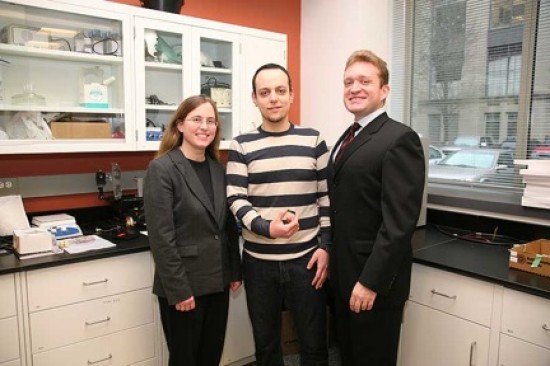Device has applications for portable pump systems and space

A research team from the Microsystems Technology Laboratories (MTL) at MIT received an award for Best Oral Presentation at the 2009 International Workshop on Micro and Nanotechnology for Power Generation and Energy Conversion Applications (PowerMEMS). The workshop, which was held from December 1-4, 2009 in College Park, MD, is an annual event for researchers around the world specializing in power conversion and energy generation research using micro- and nano-electro-mechanical systems (or MEMS/NEMS). The team consists of Mechanical Engineering Professor Carol Livermore, MTL Principal Scientist Dr. Luis Fernando Velasquez-Garcia, and Mechanical Engineering doctoral candidate Feras Eid. Their paper was titled “Design, Fabrication and Demonstration of a MEMS Steam Generator for Ejector Pump Applications.”
The merits of this research lie in the development of a device that achieves results sought after by MEMS researchers for over a decade: this chemical reactor can fully decompose hydrogen peroxide into water vapor and oxygen while also releasing heat. The MIT team successfully achieved full decomposition of the hydrogen peroxide, as well as vaporization of the water, by combining thorough multi-domain modeling with a design that simultaneously maximizes heat generation and minimizes heat losses. “Down-scaling is a challenge for small scale hydrogen peroxide decomposition, but one that can be addressed by efficient use of the energy released during decomposition,” Professor Livermore said.
Another key part of the success of the reactor technology is its choice of catalyst. “Most of the work on hydrogen peroxide reactors involves a solid catalyst that is prone to poisoning from stabilized peroxide, and that in general limits the lifespan of the reactor. We decided to implement instead a reactor that rapidly mixes the peroxide with a liquid catalyst flow to facilitate decomposition. The choice of a homogeneous catalyst greatly enhances the use of this technology for long-term applications,” Mr. Eid said.
The steam reactor could even be used to power microrockets. Other monopropellant rockets may use hydrazine, a highly toxic and unstable compound. “We have developed a reactor technology that can be used in combination with a suitable expansion nozzle to deliver thrust levels at a specific impulse that can satisfy a wide range of impulsive maneuvers in nanosatellites,” Dr. Velasquez-Garcia said, “In addition, hydrogen peroxide-based monopropellant rockets are a very attractive green option to the hydrazine-based counterparts.”
